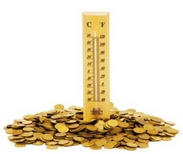An ETF to boost your portfolio whatever the weather
 Despite stagnant wages and increased borrowing, Americans ramped up their consumer spending in January. The United States Department of Commerce said earlier this week that consumer spending rose 0.4% in January versus a forecast of 0.2%. (Source: “Real Consumer Spending Rises in January,” Bureau of Economic Analysis web site, March 3, 2014.)
Despite stagnant wages and increased borrowing, Americans ramped up their consumer spending in January. The United States Department of Commerce said earlier this week that consumer spending rose 0.4% in January versus a forecast of 0.2%. (Source: “Real Consumer Spending Rises in January,” Bureau of Economic Analysis web site, March 3, 2014.)
Unfortunately, January’s boost in consumer spending wasn’t as broadly based as many were hoping. Spending on durable goods, which include cars, fell 0.3%, while spending on non-durable goods, such as clothing and food, fell 0.7%.
Consumer spending on services increased 0.8%—the biggest jump in services since October 2001. The increase in services spending can be attributed to higher heating bills and more and more people signing up for Obamacare. In fact, without the 11.3% jump in utility bills, consumer spending would have essentially been flat.
For an economy that gets roughly 70% of its growth from wide-based consumer spending, these results are not spectacular.
The increase in consumer spending comes on the heels of a report from the Bureau of Economic Analysis that personal income levels climbed 0.3% month-over-month in January after remaining flat in December. (Source: “Personal Income and Outlays, January 2014,” Bureau of Economic Analysis web site, March 3, 2014.)
This is pretty much in step with consumer spending. But there is an economic disconnect happening. While consumer spending fuels economic growth in this country—if left unchecked, consumer spending can also help throw the economy off a cliff.
According to the Federal Reserve Bank of New York, at $11.52 trillion, overall consumer debt levels (including mortgages, auto loans, student loans, and credit cards) are at their highest levels since 2011—and they’re rising at an unprecedented rate. Personal debt levels rose 2.1%, or $241 billion, in the fourth quarter of 2013, the fastest rate since the third quarter of 2007. This was right before the U.S. tumbled into recession. (Source: Frizell, S., “Americans Are Taking on Debt at Scary High Rates,” Time web site, February 19, 2014.)
The increase in consumer spending is coming at the cost of an unsustainable increase in personal debt levels. Today, just 28% of Americans have more credit card debt than they have in a savings fund. And 51% have more emergency savings than credit card debt.
Gross domestic product (GDP) growth is also coming at a time when real disposable personal income is actually on the decline. During the fourth quarter of 2012, real disposable income per capita stood at $37,265; in the fourth quarter of 2013, real disposable income per capita was $36,941. (Source: “Real disposable personal income: Per capita,” Federal Reserve Bank of St. Louis web site, last accessed March 6, 2014.)
Unlike personal income level calculations, which are based on the month-over-month increase in wages, real disposable income per capita determines how much we actually have for spending after paying taxes.
So, taken together, consumer spending levels aren’t as rosy as they appear. In addition, personal debt levels are at dangerous highs and real disposable income per capita spending is down.
With the winter weather being blamed for all of our economic ills, Wall Street better hope for a warm, sunny spring to kick-start the economy. Those who think the U.S. economy needs more than a boost in temperature may want to consider a number of investing ideas.
Whether it’s hot, cold, or really cold, Americans need the support of utility companies. One investing idea you may want to consider, then, is the Utilities Select Sector SPDRA (NYSEArca/XLU) exchange-traded fund (ETF), which is up 5.7% year-to-date—the S&P 500, meanwhile, is up just 1.5%.
More News
Trump planning to stockpile deep-sea minerals to counter China: FT
April 13, 2025 | 07:56 am
Goldman Sachs upgrades gold forecast again to $3,700
April 12, 2025 | 08:05 pm
{{ commodity.name }}
{{ post.title }}
{{ post.date }}




Comments